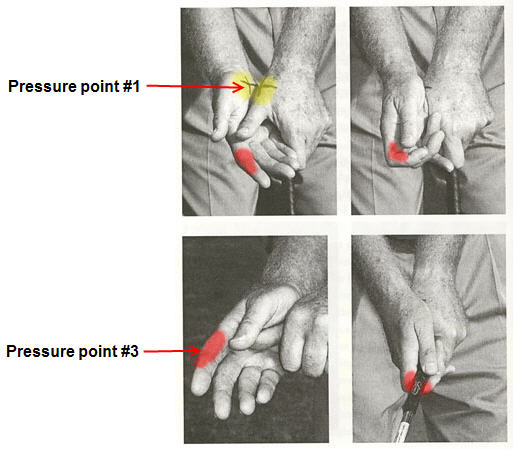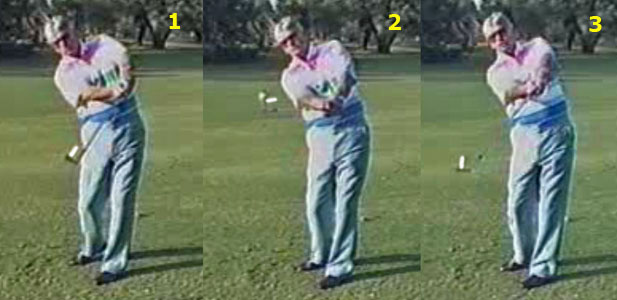Part I -- http://3jack.blogspot.com/2009/05/hitting-revelations-part-i.html
Part II -- http://3jack.blogspot.com/2009/05/hitting-revelations-part-ii.html
Again, these are my revelations and they may or may not work for you.
1. I'm hitting the ball very consistently right now and a big thank you goes out to Mike Maves (aka Sevam1). In Mike's latest update of his e-book, 'The Secret Is In The Dirt' he talks about lag not being about 'maintaining angles' and instead about 'maintaining pressure.' Sevam likes to talk about footwork and I agree with him, but that's not my main 'revelation.'
As I stated in my second part of my 'hitter revelations' I really feel that #1 Pressure Point pressing into the base joint of my left thumb. Almost like a palm heel strike with my right arm.

One of the 'revelations' that I've had is that I have to feel like the most amount of pressure applied with the #1 Pressure Point is right at impact. Homer Kelley talks about the 'drive loading hitter' needing to have a S-L-O-W startdown and I have found the very best way for me to have a S-L-O-W startdown is to just focus on the maximum amount of pressure right at impact. This is especially crucial when I want to hit a big bomb. Instead of thinking about getting the most amount of clubhead speed, I need to think about betting the most amount of pressure and getting that pressure right at impact. Because if I start concerning myself speed, the speed winds up occuring at the startdown. Every golfer wants the max speed at impact. But, I don't concern myself with speed now. I concern myself with pressure and getting max pressure at impact and that gets my max speed. Right now I'm hitting the driver very, very well.
2. Strangely, the #3 Pressure Point in the downswing does not work for me. It's great in the backswing, but in the downswing if the pressure is more towards the #3 pressure point instead of the #1 Pressure Point, I will sling hook it. Even more strange, if I get the pressure up in the middle and ring fingers of the right hand I hit a cut.
3. I went over the hinge actions in a recent post (http://3jack.blogspot.com/2009/06/understanding-basics-of-tgm-part-vi.html) The hitter uses the angled hinge action. The swinger tends to use the horizontal hinge action. Here's a Tom Tomasello picture of him using all 3 hinge actions, make sure to see where the white stripe is pointing on the clubface.
Pic 1 = Angled Hinge
Pic 2 = Horizontal Hinge
Pic 3 = Vertical Hinge
Over at LynnBlakeGolf.com I asked about the hitter 'horizontal hinging' and was told it was not advisable because it's not the natural hinge action of the hitter (angled hinge action is).
I've found this to be true because now you're just adding timing into the equation and if your get the face closed too quickly, you'll hit a hook. When I want to horizontal hinge, I just feel like I'm hinging until the right palm is facing the ground. In fact, it's very much like Brian Manzella's 'Never Slice Again 2.0' pattern, except without the backswing twistaway.
And that's exactly how it works. If I'm in a position where I cannot afford to hit a slice, go with horizontal hinging and I'll be fine. Today on #18 I had to lay up since we were playing 4-man best ball and the rest of my playing partners were out of the hole. So I pulled out the 4-iron with a downhill lie and water all along the right side. So I went with the horizontal hinge, sort of a half version of Manzella's 'Never Slice Again 2.0' and I striped it perfectly down the middle and had a wedge to the green.
I also used this a couple of times with the driver. But it really only works if I play the ball wayyy up in my stance. Again, make sure there's quite a bit of room on the left side just in case you hook it. On #12 I used it after getting sick and tired of hitting the right fairway bunkers and I hit a hook up the left side that went long and I was in good shape, but I don't think I would try that too often as it just missed some trees. So, if I have to hit a hook around some trees, then horizontal hinging is mandatory. If I have a shot where I cannot afford to lose it right, then I'll consider horizontal hinging. Otherwise, I'm thinking there's not a lot of use for it.
4. I use the turned shoulder plane on the downswing and I use angled hinging, both of which tend to favor a fade. If I'm struggling, especially with a cut, I find that trying to hit roundhouse hooks on the range really helps. The inside-to-out path helps with preventing coming over the top and the horizontal hinging can help make sure that the angled hinge action is not becoming a vertical hinge action.
3JACK
No comments:
Post a Comment